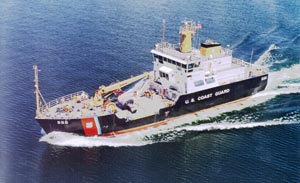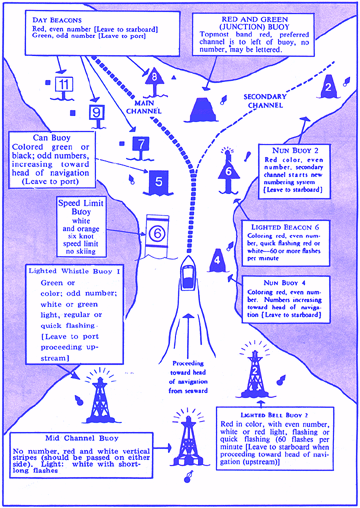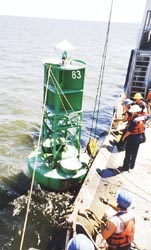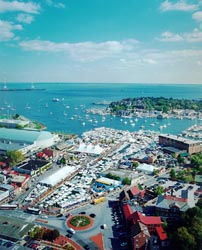 Boat Rides on the Bay
Boat Rides on the Bay Boat Rides on the Bay
Boat Rides on the Bay
The James Rankin Buoys up Boaters
Story and photos by Christopher Heagy
In a changing universe, boaters put their faith in buoys. Here's how those 'stars' get set in our Bay universe.
It's late at night. You're steering a vessel under cover of darkness.
Your boat may be a sailboat pushing home from a trip across the Bay, a fishing charter heading to the docks after a good day or a Bayliner cruising during a warm autumn night.
Or your ship may be 1,000 feet long with a beam close to 100 feet and loaded with millions of dollars of cargo.
Either way, running aground is not an option. You could care less about all the work that goes into maintaining buoys. Right now, you're just glad you see that flash. The water is deep enough. You're where you ought to be. You're out of danger.
Pleasure vessels get into all kinds of trouble all the time. Usually,
size, tides or a friendly pull get them out of it okay. But in the early
1990s, eight massive cargo ships ran aground in the Craig Hill and Brewerton
channels, in upper Chesapeake Bay. When shipping companies questioned the
navigability of the upper Bay, Baltimore's survival as a port was threatened.
The United States Coast Guard took action, placing 17 new buoys in the channels of the upper Bay. Buoys mark the dredged channels of the Bay and help keep commercial traffic safe.
Since 1992, there have been no groundings due to navigational errors in these channels.
These buoys are just as important to pleasure boaters. They help keep boaters in safe waters, mark return routes home and are welcome reminders of great fishing spots.
The Coast Guard maintains the aids to navigation in Chesapeake Bay and its tributaries to keep waterways safe and navigable for both commercial and recreational traffic. Buoy tending is a major responsibility of the Coast Guard.
"The United States has the best navigation system in the world. We have great technology and we are willing to spend the money to keep the system going," says captain and former Coast Guardsman Mickey Courtney, editor of the Bay chart book Maryland Cruising Guide.
The Coast Guard Cutter James Rankin, commissioned in May, 1999 as a 'Keeper Class' coastal buoy tender, is the newest tool to help the Coast Guard keep the Bay's channel markers where they ought to be.
In 1999, its first year in the Bay, the Rankin will visit 80 percent of the 375 buoys the Coast Guard maintains. Every lighted buoy will get a visit. Rankin tends both lighted and unlighted channel markers in Chesapeake Bay and many of its tributaries. In smaller tributaries, smaller aid-to-navigation teams maintain buoys.
Buoys at Work
The buoy's most important function is to keep boats from running aground.
"Buoys are the road signs of the sea, marking the channel. If you stay on the correct side of the channel markers, you won't run aground." Thus advises Maryland Cruising Guide.
In every body of water, buoys are numbered from one, at the entrance, ascending with odd numbers marking the channel on the left and even numbers marking the channel on the right. Odd numbered buoys are green and even numbered red. In other words, when you're ascending a body of water, you're in the channel when green, odd-numbered buoys are on your left and red even-numbered buoys on your right. When you're descending, colors and numbers reverse: green on the right and red on the left.
Where you find a buoy depends on the traffic through the area and the purpose of the channel. Is traffic mostly commercial, or is it recreational? How dangerous is the cargo that passes through the channel? How difficult is navigation in the area? Answers to questions like these guide the Coast Guard in deciding where to put buoys to meet all the needs of commercial and recreational boaters.
Every few years, the Coast Guard organizes waterway studies to review
buoy placement. Captains, shippers and insurance agencies are consulted.
Groundings are analyzed. From these studies comes a "pie-in-the-sky"
plan, describing what should be done if money were not a concern. The Coast
Guard then works with the money they've got to make the Bay as safe as possible.
Boat Meets Buoy
The autumn sun is shining brightly as the James Rankin, slowly slides into Curtis Bay. The engines are humming smoothly as the Rankin pushes into the Fort Henry Channel. The skies are clear and the Bay is calm. Despite its 175-foot length, the Rankin glides through the water, getting up to top speed at 12 knots.
The Rankin is making a two-hour journey to Buoy 82, between Tilghman Island and North Beach, to begin a full day of buoy tending on Chesapeake Bay.
"What we're doing today is giving the buoy a shave and a haircut," says the Rankin's Operations Petty Officer David Lewald, who schedules the buoy tender.
"We go out, inspect the lights, solar panels, make sure there are no cuts or nicks in the wiring, check the voltage, make sure the light will show the proper characteristic, scrape off the mud and clean it. In an hour and a half or two hours, we set it back in the water."
The Rankin has given over 300 of these shave-and-haircuts in the past year.
What looked like a tiny fishing bobber on the horizon has grown into a giant steel beast. The Rankin approaches slowly and pulls tight to this enormous buoy.
The numbered buoys that mark the main shipping channel of the Bay are made of steel. Even though they're hollow, these buoys still weigh between 7,500 and 11,000 pounds.
The buoys have four parts. The hull keeps the buoy afloat. Above the hull, a girder-work cage supports a light and solar panel. The counterweight is under water, stabilizing the buoy. From the hull is suspended the bridal, a steel chain connected to both sides of the buoy to link it to the chain that anchors it to its location.
"The purpose of the James Rankin," explains Lewald, "is to get these men and that crane to the buoy. The Rankin was built with incredible maneuverability. It draws eight feet of water."
The Rankin has all the tools the deckhands need to work buoys. Cranes, chain-in-haul winches, cross-deck winches and stoppers increase the efficiency of buoy tending.
Many boats have single- or double-propulsion engines that thrust only forward or in reverse, which limits maneuverability. But the Rankin has twin Z-drives that can rotate propulsion 360 degrees. These Z-drives, along with a 400-horsepower bow thruster, let the Rankin spin on a dime, move sideways or at angles and turn circles. The 175-foot long Rankin can stop and turn within its own length.
High tech from stem to stern, the Rankin can be programmed to maintain location and compensate for wind and current. It can be controlled manually or electronically.
"The machinery on the Keeper Class is standard. The engineering is not that advanced," says machine technician first class Wayne Nickle. "The difference is the electronics. The computer systems can run everything together."
The Coast Guard also uses technology in place of manpower. The "minimally manned" Rankin has a crew of only 19.
With the Rankin pulled into position, the men on the 1,335-square-foot buoy deck throw a rope around the cage, hold the buoy tight to the side of the deck and go into action. They spend the next two hours first hooking, guiding, pulling, then inspecting, welding, hammering and cleaning the buoy.
Out of the Water and on Deck
To lift the 11,382 pounds of Buoy 82 out of the Bay, the Coast Guard crew passes a chain extension through a hook on the hull of the buoy. This extension connects to the 20,000-pound hydraulic lift at the bow.
Another hook, from one of the four cross-deck winches on the buoy deck, is attached to the opposite side of the buoy. The crane slowly lifts the buoy out of the water while the winch pulls the buoy toward the deck. Tilted sideways, the buoy rises.
The crew on deck is enlisted men in their late teens and early 20s. They wear dark blue uniforms, bright orange life jackets and hard hats that give them the look of construction workers.
As the buoy rises, the chain connecting the buoy to the sinker follows, dripping water. To secure the buoy, the crew guides this chain into a stopper on the deck. Locking the chain prevents a wave, a gust of wind or any sudden movement from jerking the buoy back into the water, endangering the workers on deck.
"The first couple of minutes, when we are pulling the buoy up and the chain is not in the stopper, those are the tense moments," explains Rankin Captain Paul Dilger. "Once the chain is in the stopper and we put the buoy down, it's much safer."
A chain-in-haul winch at the bow of the boat drags the steel chain into the stopper, where it is locked and secured.
With the chain secured, the buoy settles onto the deck.
The buoy rests on a gurney, two wooden blocks connected by rope at the top and bottom. Another block of wood is slammed underneath to support the buoy. Then the buoy is chained down to the Rankin's deck.
Buoy Aboard
Once secured, the buoy is attacked.
One deckhand climbs the cage and inspects the buoy's solar panel, battery and lights. Is its characteristic flash correct in repetition and duration? Each buoy has a built-in six-bulb changer that rotates as a bulb is burned out. It is now stocked with new bulbs. The battery pack that controls the "characteristic" is tested and recharged. The clear plastic cover of the solar panel is cleaned to operate efficiently.
Above the deck, the bridge feels like a modern executive office. The integrated ship's control system dominates the room. Giant windows surround three walls. There are digital maps, depth finders, and speed gauges throughout the room. The bridge is soundless; the noise from the work on deck seems far away. Comments between officers break the lull, but there is no background noise.
The officer on deck consults the Rankin's advanced Global Positioning System to verify the location of the buoy.
"All buoys are on a global positioning system," Lewald said. "We can find out if they are off their mark and fix their location. We used to have to do that with a sextant. This positioning system might not be as precise, but you can't use a sextant in fog, bright sun or rough weather."
Back on the deck, as maintenance at the top of the buoy continues, other deck hands are working on the bottom of the buoy system. The huge blocks of concrete that hold the buoys to their location are called sinkers. Sinkers come in three weights: 7,000, 12,500 and 18,000 pounds. Different sinkers are matched to the size and location of the buoy. The sinkers for 35-to 50-foot deep channel markers like Buoy 82 and Buoy 83 usually weigh 18,000 pounds.
A chain-in-haul winch at the front of the buoy-deck pulls the buoy's sinker off the bottom of the Bay so its condition can be checked. As the chain connecting the buoy and the sinker is pulled up, the chain is inspected to make sure it is still strong enough to hold the buoy.
The steel chain that connects the buoy to the sinker has three parts. The bottom chain is connected to the sinker and sits on the Bay floor. The riser connects the buoy's bridal to the rest of the chain. The chafe connects the riser and the bottom chain. As the chafe bobs up and down with the current of the Bay, the links grind against each other, slowly wearing down.
A quarter-inch of the inch-and-a-half chain can wear away in a year of the up and down currents of the Bay. This wear weakens the chain. The decision to replace part of the chain is made based on the rate of wear, the duration between visits and a projection of when the next visit will be. If necessary, the chafe is welded off and replaced with a new chain.
The same routine is repeated buoy after buoy. To pass the time, the crew compete in a test of strength. When chain is welded off and reconnected, a new pin has to be heated and driven. The crew has 15 seconds to drive the pin before it cools. If the pin isn't in, it has to be reheated. Throughout the day, crewmen try to drive the pin without having to reheat it. They joke about poor swings and bad aim.
Four split-keys hold the pins that connect the buoy to steel chains and to the sinker. The crew make sure the split-key has not been pushed together and in danger of letting the pin slip out. The key is wedged apart if necessary.
All this maintenance is recorded to helps the Coast Guard on future trips.
"There is a book on each buoy," Lewald explains. "Each buoy has a history. There are notes on difficulty lifting the sinker, what kind of substance - mud or sand - the buoy sits in, the wear of the chafe, the number of bulbs burnt out and the condition of the solar panel."
When all this is finished, the buoy is lifted back off the deck, put back in the water, reset to the proper location. Then the Rankin is off to the next buoy.
All a Day's Work In a Liquid Environment
Days on the Rankin ebb and flow with activity and inactivity. Action comes in bursts. The crew lifts and cleans the buoy. Then the boat moves on and things slow down until reaching the next buoy. The men rest in the shade in between buoys.
The same parts are cleaned, inspected and checked on each buoy. But each buoy has a unique history and its own little quirks.
Officers watch over the crew to make sure all maintenance is done. At one buoy, the plastic covering the solar panel is still dirty after the buoy is returned over the side. So they bring it back to the boat and hold it tight to the side as a crewman hops onto the buoy, climbs the cage and cleans what was missed before.
The day's work may seem monotonous, but the Bay is never the same twice.
"Working on the Bay never becomes routine. As soon as you treat things routinely, that's when mistakes are made. That's when accidents happen," says Lewald.
The day started before sunrise and continued as the sun reached its peak and then moved lower across the horizon. As Buoy 84A is returned to the water, the crew and the James Rankin are finished for the day. The Rankin will anchor for the night and work four buoys tomorrow before returning to Curtis Bay.
"We don't work buoys at night," explains Lewald. "The sun might be setting as we finish working but we don't work after dark. No one will get hurt working buoys."
The ship is quiet as the sun sets. Tools are put away, the deck is cleaned and the crew can rest for the night. Sleep comes soon. Tomorrow starts early and maintenance of the Bay's buoys continues.
"We always joke that any day at sea is a good day," laughs Lewald. "It's still pretty cool, working in a liquid environment."
Editor's note:
"The James Rankin Buoys Up Boaters" is the fourth in our series of first-person experiences riding the big boats of Chesapeake Bay.
Like the James Rankin, some of these Bay notables were built for work. Others were built for pleasure. Many are relics of fleets whose time has come and gone. Others are brand new.
Keep steaming, sailing and motoring with us.
What's Up at the U.S. Powerboat Show
Wet-water, armchair and day-dreaming powerboaters are the kids to the U.S. Powerboat Show's candy shop. From October 14 through 17, you'll have full tantalizing run of the candy shop - looking, touching, even boarding over 425 pricey 'sweets.' That's how appetites grow.
Here's a menu of the 'sweets' and services you'll sample.
Full days of trawler seminars are scheduled on Friday and Saturday by PassageMaker Magazine. Get details at 888/487-2953.
· Half a Nautical Mile of Nautical Mall: 375 booths packed with displays of everything you need to commission a new boat or upgrade your current one. You can outfit yourself, too.
10-6 Thurs. and Sun. and 7 Fri. and Sat. Oct. 14-17 for $12 (under 12. half price) except $25 on VIP Thursday. Spreading over permanent and floating piers brought for the show to City Dock, Annapolis. To park, follow Rt. 50 to Exit #24 South to Naval Academy Stadium ($5) and ride the free shuttle
| Issue 41 |
Volume VII Number 41
October 14-20, 1999
New Bay Times
| Homepage |
| Back to Archives |